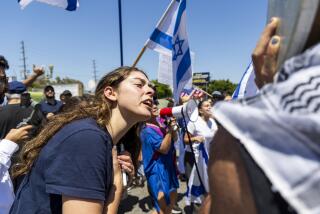Symbols May Surprise Visitors to Synagogue
- Share via
COCHIN, India — Not only Hindu temples but a synagogue constructed in the 16th Century rank as major tourist attractions in southern India.
The synagogue stands at the end of a winding street in Mattancherry, part of the port city of Cochin on the southwest coast in the state of Kerala.
As they approach the synagogue, visitors are taken aback by street signs that indicate they are in “Jew Town.” And they are shocked by the swastikas that decorate the buildings along with the Star of David.
Guides quickly explain that in India, the swastika antedates Hitler. It is an ancient Hindu religious symbol that denotes good fortune. Furthermore, the “spokes” face in the opposite direction from those of the Nazi emblem.
Jackie Cohen, synagogue caretaker, emphasizes that the name Jew Town is not degrading. “It’s a great honor here,” he said, adding that early Jewish settlers were respected by their Indian hosts.
First Jews
The first of the Jews are said to have landed in AD 72 at Cranganore, an ancient seaport north of Cochin. Some theories hold that they arrived earlier, before the Christian era.
In AD 379, a date that is also disputed, the Jewish leader Joseph Rabban was named prince of the village of Anjuvannam by the king, Sri Parkaran Iravi Vanmar. Facsimiles of the copper plates that listed Rabban’s honors and privileges are sold at the synagogue as souvenirs. The originals are in safekeeping.
Marauding Moors and the Portuguese eventually destroyed the Jewish settlement at Cranganore, which was known as Shingly, and the last Jewish prince, Joseph Azar, swam to Cochin carrying his wife on his shoulders.
The Jews then placed themselves under the rule of the Maharaja of Cochin, and in 1568 built their place of worship next to his palace. This story is told in a series of paintings by Hindu artist S. S. Krishna that are on display at the synagogue.
A more thorough account of these events is in a pamphlet titled “Kerala and Her Jews” by S. S. Koder. Visitors can buy a copy for five rupees (about 30 cents).
Many of the old-time Cochin Jews were spice traders, and that business still thrives. Trucks laden with sacks of cardamom, pepper, ginger, turmeric and other seasonings often crowd the narrow streets.
The once thriving Jewish community has dwindled to fewer than 30. Many have migrated to Israel in search of work and marriage opportunities that are lacking in Cochin.
No Bar Mitzvahs
Most of those who remain are elderly. Cohen is 65 and has no plans to resettle in Israel. “What will I do there? Even the army won’t take me,” he said. The youngest member of the community is a 16-year-old girl who is expected to leave. Bar mitzvahs are a thing of the past because there are no boys.
Although the community is small, services are held regularly on Friday nights and Saturday mornings. The synagogue has no rabbi. “Any of us can conduct services,” Cohen said. Elders--those who are older than 70--officiate for the high holidays.
Cochin Jews speak the local language, Malayalam rather than Hebrew, but use Hebrew for services.
And they follow strict Jewish dietary practices, including the use of a separate set of utensils and china for Passover. Instead of mutton or beef, they eat fish or chicken. Cohen handles the kosher slaughter of the chickens.
The synagogue is open to visitors from 10 a.m. to noon and from 3 to 5 p.m., except on Saturdays and Jewish holidays.
It is a small structure with furnishings from Europe and Asia. The chandeliers came from Belgium, as did the glass that holds the Eternal Light, which burns before the Ark containing the scrolls of the Torah. A silver basin and pitcher for washing hands were made in Germany.
The 420-year-old brass pulpit is Indian. And the striking blue and white Chinese tiles that cover the floor were imported from Canton in 1762. The tiles are hand-painted, and each is slightly different from the rest.
Women worship in an upstairs gallery that is screened off by brass latticework. A plaque indicates that the mosaic flooring in an anteroom for elderly worshipers was donated by Luis Lindau of Mexico in memory of his late father, Max Lindau. That was a recent gift, the result of the younger Lindau’s visit to Cochin a dozen or so years ago, Cohen said.
Another point of interest is a framed stamp issued by the government of India in 1968 commemorating Indira Gandhi’s visit to the synagogue. The 20-paisa stamp says “Cochin Synagogue, 1568-1968” and shows the pulpit, Ark and Eternal Light. “You can’t get it now,” Cohen said.
Israeli Visitors
Among the tourists who visit the synagogue are Israelis who have learned of it from Cochin emigrants. A young woman touring India after completing her Israel military service was moved by what she saw. “It isn’t the beauty, it’s the meaning,” she said.
According to Cohen, there were once eight synagogues in Kerala. Only the one in Mattancherry still functions, and one day the Cochin Jews will no longer be able to form the quorum of 10 that is required to hold services.
But the end of this unique community will not mean the end of the synagogue. “We’ll hand it over to the government to keep as a monument,” Cohen said.
For more information on travel to India, contact the Government of India Tourist Office, 3550 Wilshire Blvd., Suite 204, Los Angeles 90010, (213) 380-8855.
More to Read
Sign up for The Wild
We’ll help you find the best places to hike, bike and run, as well as the perfect silent spots for meditation and yoga.
You may occasionally receive promotional content from the Los Angeles Times.






